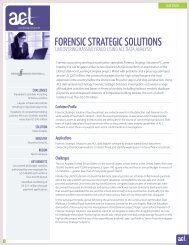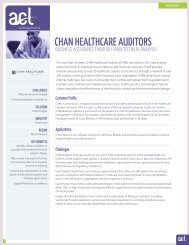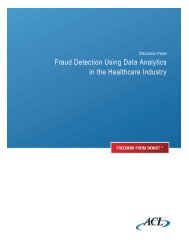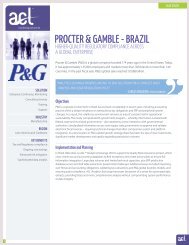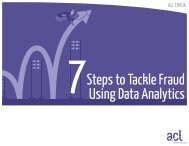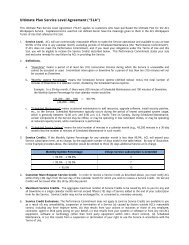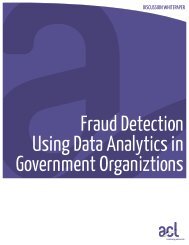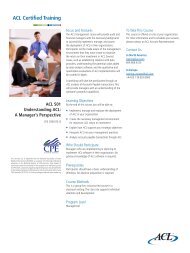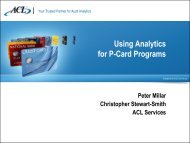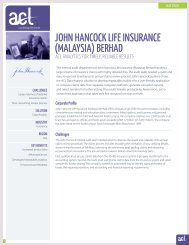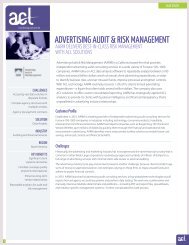Integrating Working Papers with Audit Management - Acl.com
Integrating Working Papers with Audit Management - Acl.com
Integrating Working Papers with Audit Management - Acl.com
- No tags were found...
You also want an ePaper? Increase the reach of your titles
YUMPU automatically turns print PDFs into web optimized ePapers that Google loves.
WHITE PAPER“One of the key challenges <strong>with</strong> generalized tools is that they are not built for audit. In general, productcapabilities, features and workflow are not instinctive to core audit processes.” | Jay Postma, CAMSPresident, MSB Compliance, Inc.The use of general-purpose software and manual or custom systems for working papers documentationoften results in management inefficiencies and configuration challenges that are costly and can have anegative impact on audit performance. Here’s why:Shared-drive ‘chaos’Many audit teams organize and store audit project files on network storage or email servers, organized<strong>with</strong>in a conventional file folder structure. Over time, file management be<strong>com</strong>es unruly, inefficient andcostly.Common issues <strong>with</strong> conventional file folder management:■■■■■■■■Prone to version control errors. For example, auditors may select, share and/or update a wrong oroutdated version of audit report.Limited control over access to information and files. For example, auditors are unable to limit or grantaccess to certain information based on stakeholder type (auditor, client, process owner, executive,external auditor, etc.) or workflow requirements.Mobile accessibility is impossible in most cases; challenging at best.Inconsistent file management structure triggers duplicate information, and creates inefficiencies,errors and organizational challenges.As an example of these challenges, Linford & Company LLP, a mid-tier CPA firm providing internal auditand other assurance services to global clientele, saved all audit project files on individual auditors’<strong>com</strong>puters and shared network drives. As the firm’s client base, scope of work, and team grew; theorganizational structure of Microsoft¨ Office documents stored on shared drives became unruly andinefficient. Workflow for facilitating the creation, review and sign-off of those working papers was<strong>com</strong>pletely manual, cumbersome and prone to errors. As a result, team members spent significant time-- approximately 30% of overall project time -- on coordination activities and administration. Makingmatters worse, the disorderly workflow often contributed to duplicate files <strong>with</strong> confusing naming;inconsistent work papers referencing schemes across team members; control information and findingsthat were not fully synchronized across multiple spreadsheets; and other disorganization that was difficultto tame. 1Enabling mobile fieldwork<strong>Audit</strong> teams have always spent significant time in the field conducting observations and testing.Historically, those observations are captured by the auditor in notes and then translated into the workingpapers in some form upon return to the office.However, new technologies such as smartphones, tablets, and increased use of mobile laptop PCs havecreated an expectation and demand among auditors. They want to be able to <strong>com</strong>plete their workanytime, from anywhere, <strong>with</strong>out having to return to the office. With proper tools and processes in place,an auditor in the field may capture observations, insert those into the proper working papers <strong>with</strong>in theaudit plan, and sign-off the work directly from their smartphone.The gain in productivity from leveraging mobile should be a key priority for all audit teams that operateon constrained resources.1 Linford & Company LLP was co-founded by author Dan Zitting. To address these challenges, he and his team developed a web-based electronic work papers solution. As demand for this software increased, Zitting foundedWorkpapers.<strong>com</strong> which was acquired by ACL in late 20116
WHITE PAPERAdded costs for configuration, training and customizationSome organizations deploy enterprise content management systems (ECM) or enterprise collaborationsoftware such as Microsoft® SharePoint. Often viewed as a first step toward more <strong>com</strong>prehensive auditproject management, these solutions are designed for general business processes and therefore lackintuitive audit process management and require customization and training.Common issues <strong>with</strong> general-purpose solutions:■■■■■■■■■■Most general-purpose content management solutions do not provide a consistent framework toenforce audit-specific workflow.No consistent working papers numbering scheme and cross referencing is required. Direct linkagebetween audit elements is not enforced.Products are designed for general business processes rather than audit, and therefore requirecustomization or specialization for audit processes which usually requires significant assistance from,and dependence on, the IT department.Purchase and deployment costs can be quite high; often prohibitive for small or medium sizeorganizations.Often require added training and/or lengthy requirements definition <strong>with</strong> long and <strong>com</strong>plexinstallation process.Disparate audit functions and workflow silosDifferent workflows exist for different functions of the audit process: audit project management, workingpapers, data analysis, external review, and reporting. These workflows are made up of people, processesand in most cases, technology. As audit capabilities mature and organizations implement differentsoftware or <strong>com</strong>puter assisted audit techniques (CAATs) to automate their audit process, a <strong>com</strong>mon riskfor many organizations is that workflows be<strong>com</strong>e overly <strong>com</strong>plex and disjointed.<strong>Audit</strong> Performance GapThese silos, disparate processes and disjointed technology create an unnecessary <strong>Audit</strong> Performance Gap where:■■■■■■productivity is stifled by redundant and manual project management;inefficiencies and inaccuracies are <strong>com</strong>mon and use unnecessary or costly resources; andrisks are overlooked and opportunities for continual improvement are missed.<strong>Audit</strong> <strong>Management</strong> <strong>Working</strong> <strong>Papers</strong> Data Analysis■■■■■■■■■■PlanningFieldworkReviewReportingFollow-up■■■■■■■■Document resultsOrganizesupportingevidenceIdentify findingsReview & sign-off■■■■■■■■■■Identify requirementsTechnical assessment& rolloutData Analysis planAssign stakeholders &rolesAssess riskFigure 1: Workflow Silos7
WHITE PAPERThe <strong>Audit</strong> Performance Gap represents the strategic value that is lost due to inefficiency in the auditmanagement process.By closing the gap, administrative tasks and resources can be redirected to strategic and valuable auditactivities such as enhancing audit analysis techniques, conducting additional audits, evaluating additionalorganizational risks, or training and up-skilling audit staff.“For a long time the choice for auditors has been between <strong>com</strong>plex-to-configure audit management systems orpiecing parts of the Microsoft Office suite together to create and organize audit documentation. A streamlinedand simplified working papers solution solves these problems and lets auditors focus on delivering accurate,high quality audit findings.” | John Verver, CA, CMC, CISA, Vice President of Product Strategy & Alliances, ACLServices Ltd.The case for convention over configurationIn order to optimize audit documentation and team productivity, the key is to provide a strong auditconvention or framework that is flexible, however not so much that it loses its ability to provide structurefor consistency.Consider this: A new car <strong>with</strong> the option to configure the gas pedal on the left side floorboard or the rightdoes not qualify as “a flexible solution” or “rich customization.” In fact, some may consider it a flaw. Leftconfiguration would force drivers to reconsider their driving convention and therefore require training,extra evaluation time and, until fully <strong>com</strong>petent, some extra time calculating each action while drivingand maybe even an increase in errors. It also has unforeseen future implications. What if you decided theleft-side pedal configuration was good; you learned to drive that way, but then later wanted to upgradeto a different car that only offered the right-side pedal? What if someone else who hadn’t been faced <strong>with</strong>that decision needed to drive your car? The same principle holds true for audit management solutions.Flexibility is good but straying too much from convention can derail productivity and hamperperformance. This is why purpose-built audit management solutions, including electronic working paperssolutions, are better suited for audit organizations. These solutions are designed from the ground upspecifically for audit. They have a built-in validation process to help streamline workflow for efficiencygains, reduce the risk of errors and let auditors focus on what’s important: providing oversight and value.From ‘<strong>com</strong>mon practices’ to ‘best practices’Focusing on three practical steps is the key to establishing best practices for working papersmanagement and to closing the performance gap.1. Integrate working papers documentation into the audit management process<strong>Working</strong> papers have a direct correlation to audit performance. Work papers can provide valuableintelligence to other audit functions, from overall audit management to team collaboration and auditanalytics and risk assessment.A recent survey <strong>with</strong> over 8,000 ACL customers indicated a 75% interest in an integrated analytics andelectronic working papers solution to improve efficiency and increase the use of technology in their auditdepartments.A fully automated working papers solution that links the documentation itself into overall projectmanagement delivers audit intelligence that helps drive value in the following areas:■■■■■■Provides a framework for productive execution— More audit and analysis, less documenting.Streamlines fieldwork, documentation, and reporting— Enables resource-strapped auditdepartments to ac<strong>com</strong>plish more than they could using manual techniques.Facilitates team <strong>com</strong>munication— Keep everyone on the same page and focused on the same goals.8
WHITE PAPER2. Favor convention over configurationDefine the convention <strong>with</strong>in the audit processRevisit the audits <strong>com</strong>pleted <strong>with</strong>in the last 12 months and determine what was reported to the keyaudit stakeholders (likely the organization’s audit <strong>com</strong>mittee and/or senior management). Look at theaudit work performed across those audits to support that reporting and identify areas of similarity as wellas the differences and inconsistency. Usually, 80-90% of the processes and documentation formats fromone audit to the next should all be the same. Focus on the 80-90%, and simplify those <strong>com</strong>monprocesses as much as possible. Select an audit tool that enforces your convention and leaves as littleroom as possible for deviation.Eliminate the need for configurationAvoid customization beyond the workflow convention. Also, avoid tools <strong>with</strong> overly <strong>com</strong>plex optionsaround installation, periodic upgrades, assignment of user roles, syncing and other non-audit value areas.3. Redirect resources to strategic audit activitiesAs time benefits are realized from steps 1 and 2, you can redirect that time to high-value audit activities.Key opportunities often include:■■■■■■■■Conducting additional auditsEnhancing audit techniques, particularly the use of data analysis to evaluate higher volumes oftransactional data (and move audits from sample testing to full population testing)<strong>Audit</strong> team training in strategic areasDevoting additional attention to risk assessment activities and identifying additional risk areasThe unexpected value driven from redirected administrative time will solidify the role of Internal <strong>Audit</strong> (orother audit teams) as strategic business partners to the <strong>Audit</strong> Committee as well as the CEO, CFO, andother members of executive management.Roll-forwardScope the <strong>Audit</strong>ArchiveBuild <strong>Audit</strong> PlanTrack FindingRemediationPlanningRequestInformationIncremental CapabilityWhen Tightly<strong>Integrating</strong> <strong>Audit</strong>ManagmentReport ResultsTrack StatusFollow-upThe <strong>Audit</strong> CycleFieldworkAnalyzeInformationRole of DataAnalysis ToolsReportingReviewDocumentResultsTrack TimeOrganize SupportingEvidenceTo-dos(Review Notes)Identify FindingsRole of Traditional<strong>Working</strong> <strong>Papers</strong>Review& Sign-offFigure 2: Best Practice: Integrated Approach to <strong>Working</strong> <strong>Papers</strong> By integrating working papers into the entire auditmanagement cycle, organizations improve risk assessments, reduce redundancies and inaccuracies, and broaden the scope ofassurance activities.9
WHITE PAPERACL audit management solutionACL GRC is a hosted audit, risk, and <strong>com</strong>pliance management system, securely accessed via the Internet,that increases audit productivity by organizing fieldwork and automating project management. Theunderlying system framework enables managers to build audit projects of any type, whether financial,operational, <strong>com</strong>pliance, or technical. The service is being used by audit firms, public <strong>com</strong>panies, banks,internal auditors, and <strong>com</strong>pliance groups worldwide.Designed for the Chief <strong>Audit</strong> Executive…■■■■■■ACL GRC provides users <strong>with</strong> hands-free audit project management, as it organizes projects, notifiesthe right people, and keeps audits on track.Facilitates an organized, productive workflow. The structure allows managers to build their auditprogram then, from any procedure, quickly and easily add findings, to-dos, client requests, and timespent. Everything is automatically aggregated to the project level for simple project managementand status tracking.Automates Comprehensive Project Reports <strong>with</strong> more than 60 pre-configured, one-click reportscovering the audit, risk control matrices, walkthroughs, test plans, testing results, status reports,detailed findings, and status reports – all available in PDF and Excel format.With the auditor’s needs in mind…■■■■■■User-friendly, intuitive interface to facilitate less time training and more time auditing.Enables users to collaborate <strong>with</strong> the audit team, executives, clients, and external parties. Centralizingaudit work in one place allows users to provide secure access to fit the needs of the differentstakeholders <strong>with</strong>in an audit project.Receive automatic email notifications for key events such as supervisor review, review notes, and more.…And leading the way in cloud application security.■■■■■■Is guaranteed to be 100% secure, private, and reliable. ACL GRC is setting a new standard in cloudapplication security <strong>with</strong> a <strong>com</strong>prehensive set of controls in place to protect customer data.Minimal up-front technology costs; costs are better controlled and converted from capital project tooperating expense.No hardware and software to install and maintain. No dependence on IT and no firewall, VPN, or othertechnical network issues. Quick setup of new users, easily managed directly by the audit team.10
WHITE PAPERCase study: 30% workflow productivity gains <strong>with</strong> ACL GRCStraight Talk Consulting Solutions in Vancouver, Canada is a provider of internal audit and riskmanagement services. To provide maximum value to its clients, Straight Talk sought a way make theengagement process more efficient when executing risk management and internal audit projects.Continuously managing multiple versions of Microsoft® Word, Excel®, and PowerPoint® files amonginternal and external parties was a major productivity obstacle. In addition, the lack of a <strong>com</strong>mon platformamong stakeholders was making it difficult to manage documentation changes, organize supportingevidence, and follow through on the resolution of engagement issues.Straight Talk looked at several different offerings, but ACL GRC immediately stood out from the pack; itwas clear that ACL GRC was designed by an auditor for an auditor. The single point of access thatintegrates documents, controls, results, tests and issues all in one place streamlines the process oforganizing work, and eliminates duplication and version control issues. Additionally, ACL GRC providedStraight Talk <strong>with</strong> a SAS 70 report detailing the integrity of the hosting environment, assuring a necessaryhigh level of confidence regarding the safety of clients’ data.With ACL GRC, Straight Talk eliminated 30% of the time previously spent on project, workflow andworkpaper management. This allows the firm to concentrate efforts on higher value audit activities, suchas process improvements and the redirection of auditor attention to additional key risk areas. Thiscontributes to improved client relationships, enhanced value delivered per resources utilized, andstrengthening audit contribution as a critical strategic asset in organizational success.CONCLUSION<strong>Working</strong> papers, when properly managed, provide valuable intelligence to other audit functions, fromoverall audit management to team collaboration, to audit analytics and risk assessment. Automatedsolutions enable teams to produce high quality, accurate and efficient workpapers that improve auditplanning, risk assessments, and expand audit coverage. With these gains, audit departments can improverisk assessments, reduce redundancies or inaccuracies, and broaden the scope of assurance activities – allcritical attributes that add greater value to their organization.While significant progress has been made in both technology and processes to establish best practices inaudit management, a <strong>com</strong>mon pitfall for many organizations is the existence of disparate silos ofinformation and business processes. <strong>Integrating</strong> working papers processes into the overall auditmanagement cycle is a best practices that can help break down audit function silos and help fold in auditintelligence and documentation though a single, effective audit execution process.As audit technology and analytics capabilities mature, auditing practices will continue to evolve toward afully integrated audit management platform. This will deliver on the promise of deep and seamlessintegration between audit project management and advanced risk and control data analytics for highimpact, high performance auditing.ACL will be integrating its working papers solution to its data analysis software to help meet this market need.For a free assessment of how your organization can establish best practices for working papersand close the <strong>Audit</strong> Performance Gap, call 1-888-669-4225 or visit: www.acl.<strong>com</strong>11
WHITE PAPERAbout ACLACL delivers technology solutions that are transforming audit and risk management. Through a<strong>com</strong>bination of software and expert content, ACL enables powerful internal controls that identify andmitigate risk, protect profits, and accelerate performance.Driven by a desire to expand the horizons of audit and risk management so they can deliver greaterstrategic business value, we develop and advocate technology that strengthens results, simplifiesadoption, and improves usability. ACL’s integrated family of products—including our cloud-basedgovernance, risk management and <strong>com</strong>pliance (GRC) solution and flagship data analytics products—<strong>com</strong>bine all vital <strong>com</strong>ponents of audit and risk, and are used seamlessly at all levels of the organization,from the C-suite to front line audit and risk professionals and the business managers they interface <strong>with</strong>.Enhanced reporting and dashboards provide transparency and business context that allowsorganizations to focus on what matters.And, thanks to 25 years of experience and our consultative approach, we ensure fast, effectiveimplementation, so customers realize concrete business results fast at low risk. Our actively engaged<strong>com</strong>munity of more than 14,000 customers around the globe—including 89% of the Fortune 500—tellsour story best. Here are just a few.Visit us online at www.acl.<strong>com</strong>12130165-White_Paper_WP_<strong>Audit</strong>_<strong>Management</strong>© 2014 ACL Services Ltd.ACL and the ACL logo are trademarks or registered trademarks of ACL Services Ltd. All other trademarks are the property of their respective owners.



